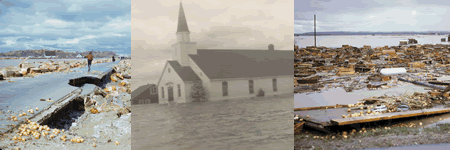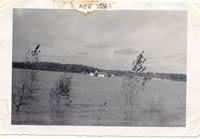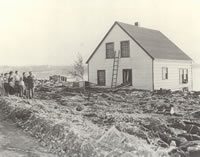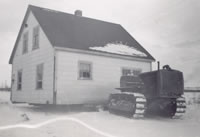

The Holland Marsh was flooded when between 4 and 20 feet [1.2–6.1 metres] of water backed up from Lake Simcoe into the marsh. The south and west ends experienced the worst flooding when between 20 and 30 feet [6.1–9.0 metres] of water backed up from the bordering Holland River and Schomberg Creek into the marsh. Highway 400 which dissects the marsh was under five to ten feet [1.5–3.0 metres] of water and the hamlet of Ansnorveldt was inundated. Approximately 1000 people were rescued from the north end of the marsh towards Bradford, while hundreds more were stranded throughout the night on high ground until rescue boats could be launched. Severe economic losses were experienced because while much of the year’s crop had been harvested, it had not been brought in and was submerged by floodwaters.
The nature of the flood in the Holland Marsh differed from that in the narrower river valleys in Toronto. The Holland Marsh flood was characterized by Charlie Davis, a local resident: “It wasn’t like down by the Humber where there was a big rush of water. The water was really quiet and it was so dark outside you couldn’t really see what was going on. But every time you looked out the door, the water had risen another six inches.” (TS, October 14, 1984)
Holland Marsh is located in a bowl-shaped valley. John Van Dyke, a Holland Marsh resident, describes the Hazel flood:
“Then came October 15, the day that it did not rain, but poured all day long. There was no let-up and by late afternoon the soil was completely saturated. The drainage river within the boundary of the Marsh was overflowing, as were the drainage ditches, and water spilled over on some of the low-lying fields. The highlands surrounding the Marsh could not absorb all this rain, and since the land slopes down towards the Marsh the drainage canal was filling up fast, the water pressing against the dykes.
“By early evening came the danger point. Water had reached the top and in some places came over the top and all able-bodied men were summoned to come out to sandbag weak spots. But the water rose so rapidly, these efforts were soon abandoned and the people were told to get out and go to higher ground.
“So most of the residents did just that and made their way to the town of Bradford which is located high on a hill an average five miles distant. People just poured into the little town–a real invasion. If there was a showing of real community spirit, an effort to help a neighbour in need, in the history of the town of Bradford, then it was on the night of October 15, 1954.” (Kennedy, 1979; p. 98)
 Allan Anderson, a CBC broadcaster described the scene in the Holland Marsh when he arrived: “It was unbelievable, the Marsh was just one vast lake. All you could see in the distance sticking out of the water was the steeple of the Springdale Christian Reformed Church. In Bradford itself it was like a war zone. The flood victims had been taken into people’s homes and the town was bursting at the seams. The town hall was full of people sleeping, crowded so close together you thought that they were almost sleeping standing up.” (Kennedy, 1979; p. 101) Allan Anderson, a CBC broadcaster described the scene in the Holland Marsh when he arrived: “It was unbelievable, the Marsh was just one vast lake. All you could see in the distance sticking out of the water was the steeple of the Springdale Christian Reformed Church. In Bradford itself it was like a war zone. The flood victims had been taken into people’s homes and the town was bursting at the seams. The town hall was full of people sleeping, crowded so close together you thought that they were almost sleeping standing up.” (Kennedy, 1979; p. 101)
Most of the properties were inundated with water, destroying or seriously damaging the homes and contents. John Van Dyke describes the damage in the marsh: “Many too were either ruined or badly damaged and furniture beyond repair. This was especially true on the Springdale side, west of Highway 400, where the water rose as high as fifteen feet, flowing clean over the highway. Two or three homes were lifted off their foundations and set afloat. They travelled for about a mile, coming to rest against a highway. One of these homes even contained an entire family.” (Kennedy, 1979; p. 102)
The DePeuter family spent the night stranded in their house as it floated around the marsh. The house was flooded up to the windows of the first floor, so the parents, 13 children and one cat fled to the second floor, where they remained all night as the house floated for two miles around the marsh. Three of the children became sea sick as the house ‘bobbed like a cork.’ Hydro remained connected to the house for the first 15 minutes.
 Henry DePeuter describes the night he and his family were adrift on the marsh: Henry DePeuter describes the night he and his family were adrift on the marsh:
“The amazing part was all the lights in the house stayed on, because we were moving towards the hydro lines, and they were slackening.
“The house just took off like a boat, a real Noah’s Ark. From 11:30 till 6:30 we floated aimlessly through the Marsh, bumping into houses, greenhouses, barns, hydro poles, everything. The area over by the Holland River had a faster current and somehow our house got caught in that current and started spinning like a top, faster and faster, and rocking to and fro. We all–all fifteen of us–would run from one side of the house to the other when it tilted, trying to balance it out. One of my younger brothers, Bastian, actually got violently sea-sick.
“Until then we had been too busy to really worry and then one of the younger ones asked if we were all going to die. My mother said that only one person knew that, the Lord, and we all knelt down and prayed, the Lord’s Prayer. And we did get out of the current and finally come to rest against a service road near the 400, where a complete field of carrots had floated up to the surface and helped hold us in place. We were two and half miles away from where we started, with lots of side trips that had often taken us near our original place.
“At that time there were still cars going along the 400 and we shouted and waved to attract their attention. I even fired off a. 22, but with the noise of the wind and the water, it couldn’t be heard. Then we waved bedsheets and motorists saw us, and soon an amphibious truck from Camp Borden came along. One man got out, tied a rope around his waist, and plunged in to swim towards our house. We were about 250 feet away and the water was pretty wild and cold but he made it. We knocked a window out downstairs and pulled him in. Then another man came along the rope in a canoe which kept tipping but he told us we’d be okay with the extra weight of two people in the canoe. So we made it out to the truck in seven trips, and were taken into Bradford, where we stayed in the Bradford Town Hall.
“We never found out the name of the man who swam out with the rope to rescue us. Then one day my brother was in Barrie, in Jack Oates’ paint store, and he got talking about the wet weather and how it wasn’t as bad as Hurricane Hazel and one thing led to another and they found out that he, Jack Oates, was the man who had saved us.” (Kennedy, 1979; p. 100-101)
 After the marsh was drained of floodwater, the DePeuter home was moved back to its original foundation intact. After the marsh was drained of floodwater, the DePeuter home was moved back to its original foundation intact.
Every day during rescue operations in the marsh people journeyed from Bradford to the dykes overlooking the marsh to determine when they might be allowed to return to their homes. Their houses could be seen in the distance protruding above the floodwaters. A housing crisis developed because of the number of displaced residents of the marsh who required prolonged emergency housing. Hundreds of homes were condemned by the health department because of contamination from the floodwaters and rotting vegetables.
Seven thousand acres [28.35 km2] of marsh area were turned into a lake by the flood, wrecking 500 homes and making 3000 people homeless. Early estimates of damages were up to $10,000,000, including more than 500,000 bags of onions and a nearly identical number of bags of celery, plus millions of bushels of other vegetables that were battered against buildings and left to float around the lake and rot.
Residents voted to block the draining of water from their properties so that the southeast section of the marsh could be drained of water. Art Vandyke, a resident of the submerged section was quoted as saying, “We have lost everything anyway. If the water could be taken down we might or might not have something to save. If the people to the east can save anything, leave our land under water for the moment!” (TS, October 18, 1954)
The western section of the marsh has a higher water level than the east because of the entry of the flooded Schomberg branch of the Holland River. The west drains to the east through a conduit that flows under Highway 400. Engineers decided to block the conduit to allow pumps to begin draining the eastern section. The time to pump the marsh dry was placed at weeks.
The local communities created 11 groups to handle the crisis in the area. Tasks included dealing with the homeless and removing objects from the marsh as the water level dropped. Trailers were considered to deal with the homeless because of the expected duration that emergency lodging was required.
Fifteen feet [4.6 m] of water had to be pumped into Lake Simcoe before the marsh could be navigated by the heavy equipment necessary for repairing damage to the marsh dykes, ditches, and canals. Plans to sacrifice one fifth of the marsh to save the rest were agreed upon. The first step was to bulldoze old cars, piles of hay, and other material into the culvert to block the flow of water from the west section of the marsh to the east section. The rest of the western section was blocked because the highway rose 15 feet. Steep Rock Mines in Atikokan shipped three 23,000-gallon pumps, the army detachment in Oakville sent 10 large capacity pumps, and Ontario Hydro installed a 30,000-gallon pump on the dyke that separates Lake Simcoe from the marsh.
 The procedure for draining and restoring the marsh was nicknamed ‘Operation Mop-up’. The operation involved approximately 2000 men over 15 days, plus private contractors working with heavy equipment. The water emitted a horrible stench from the floating rotting vegetables. One field of carrots was spotted floating in a two inch thick piece of soil that was able to float on the flooded water. Pumps had to contend with vegetables clogging their intakes. The procedure for draining and restoring the marsh was nicknamed ‘Operation Mop-up’. The operation involved approximately 2000 men over 15 days, plus private contractors working with heavy equipment. The water emitted a horrible stench from the floating rotting vegetables. One field of carrots was spotted floating in a two inch thick piece of soil that was able to float on the flooded water. Pumps had to contend with vegetables clogging their intakes.
In total 19 pumps using 25,000 horsepower (which forced the set up of three emergency substations) ran continuously to drain Holland Marsh. The water level was reduced by one acre-foot every minute and a half for a total average lowering of two inches per day [50.8 mm/day].
Approximately six to eight billion gallons [23–30 billion litres] of water were pumped from Holland Marsh’s 5000 acre [20.25 km2] eastern section in 24 days, 11 days ahead of schedule. The 2000 acre [8.1 km2] section of the marsh lying east of the highway was also reclaimed from the floodwaters. Farmers rushed to prepare their fields for the next year in an attempt to salvage their 1955 crops.
A plan to raise the level of the dykes and deepen the drainage canals was supported by local Holland Marsh residents and the provincial government. Federal support for the project was sought as the cost of expansion was estimated at $250,000. Eighteen miles [29 km] of dykes would be raised and widened and the canals would be deepened to a total depth of ten feet.
Some marsh property owners were frustrated with plans to deepen the canals and widen the dykes because silt that was dredged from the canals was dumped on properties and used as fill for the dykes that were widened and built up. The cost of using silt from the canals to fill the dykes was less than removing silt and trucking in other fill, even though there was the added cost of compensating property owners. Silt is bad soil for crops.
The 1955 crop was especially rich due to the flood in 1954. Floods enrich the soil with a high mineral content due to the influx of mineral rich sediments brought with the floodwaters. The destruction from Hurricane Hazel also allowed farmers in the marsh to modernize and automate their operations, making them more profitable.
|